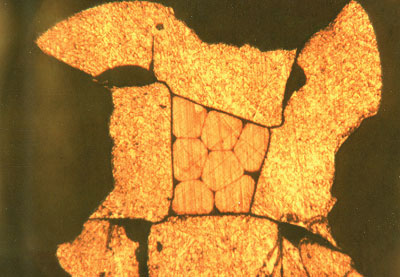A Bad Crimp – and a Worse One
 The wrong tool, or wrong procedures, is typically to blame.
The wrong tool, or wrong procedures, is typically to blame.
Crimping is a reliable process, provided design and process engineers follow the crimp supplier’s guidelines on crimp wire capacity and the crimp tool settings. Both of these points would have prevented these horror stories. In recent years, good inspection and in-process control of the wire and cable preparation has been enhanced with the launch of IPC/WHMA-620, “Requirements and Acceptance for Cable and Wire Harness Assemblies.”
From discussions with those responsible for calibration, certification and approval of crimping, it is easy to see what can go wrong. When correct procedures are followed, crimps are extremely reliable, but when production does not want to buy the right tools, calibrate equipment or train staff, it can go wrong. Big time.
FIGURE 1 shows over-crimping where the depth of indentation is causing the crimp bucket to crack. This would have been visible without cross-sectioning the terminal. The over- crimping was probably attempted to compensate for the reduced cross-sectional area of the wire in this crimp. Clearly this would have been outside of the supplier’s intended guidelines.

Figure 1. Cross-section showing over-crimping, causing the crimp bucket to crack.
FIGURE 2 shows an attempt to put too much wire into a crimp. The crimp tool has compressed the crimp and wire. Again, visual inspection would have shown an incorrect combination of wire and crimp. It is surprising the operator was able to release the crimp tool to remove the crimp. It would not be surprising if a basic crimp tool with no full cycle ratchet were used.

Figure 2. A wrong combination of crimp and wire, probably caused by the wrong crimp tool.
These are typical defects shown in the National Physical Laboratory’s interactive assembly and soldering defects database. The database (http://defectsdatabase.npl.co.uk), available to all this publication’s readers, allows engineers to search and view countless defects and solutions, or to submit defects online. To complement the defect of the month, NPL features the Defect Video of the Month, presented online by Bob Willis. This describes over 20 different failure modes, many with video examples of the defect occurring in real time.
is a consultant at the National Physical Laboratory (npl.co.uk); martin.wickham@npl.co.uk. His column appears monthly.
Press Releases
- Altus Group Expands Aftersales Team to Its Largest Size to Date
- Incap Estonia Invests in New Flying robe System to Advance Production Performance
- Critical Manufacturing Partners with Canonical to Expand Cloud-Native Deployment Options for Manufacturers
- Heller Industries Becomes the Latest Partner to Join THE SMT FUTURE EXPERIENCE







